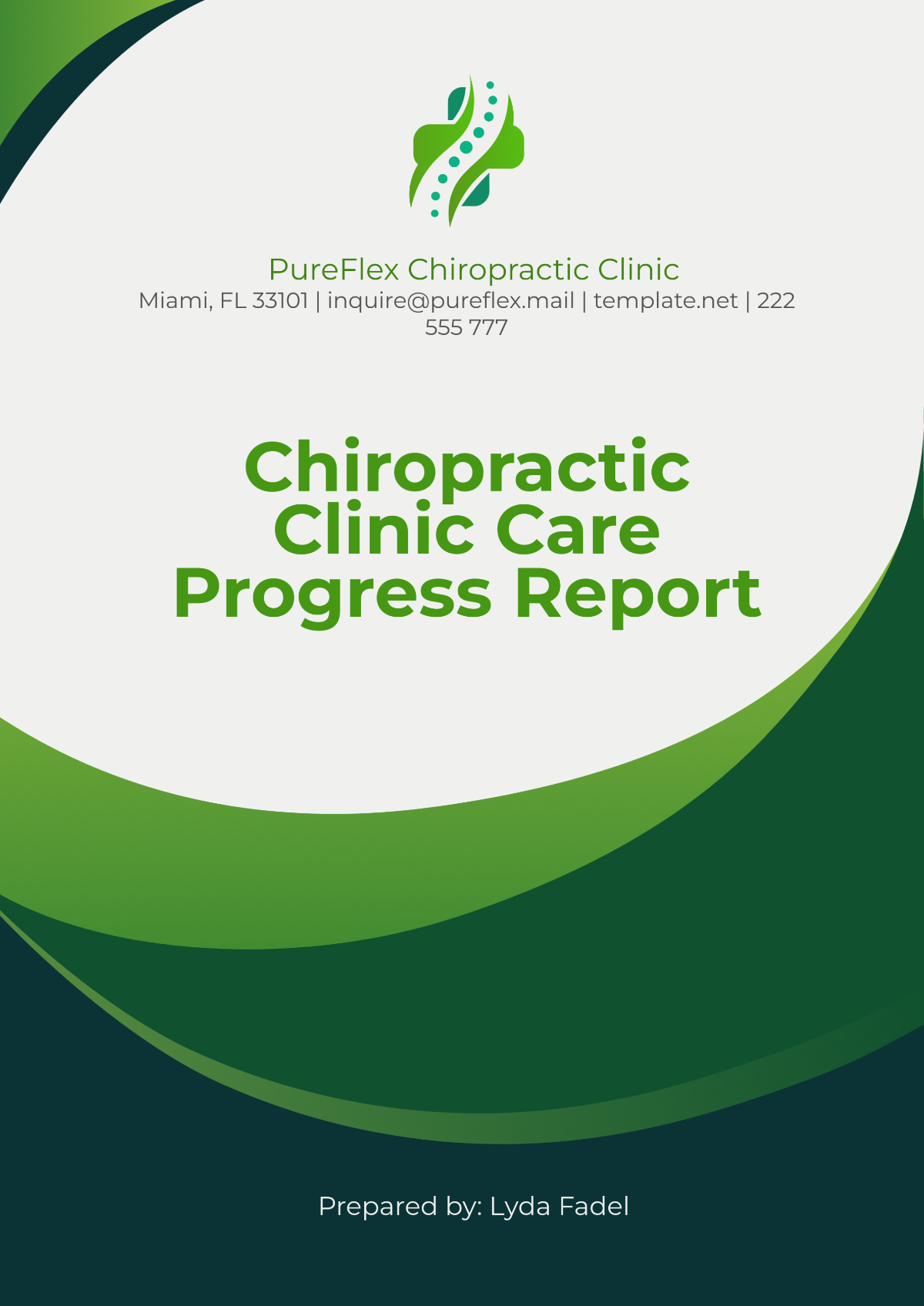Free Chiropractic Clinic Care Progress Report

I. Patient Information
A. Full Name: [Patient Name]
[Patient Name] is a [00]-year-old male who has been a patient at our chiropractic clinic for approximately 2 months. He is a regular participant in his care and has been diligent in attending scheduled appointments. His general health is good, with no major underlying conditions affecting his chiropractic care.
B. Date of Birth: March 15, 1985
[Patient Name] was born on March 15, 1985, making him [00] years old at the time of this report. His age is relevant as it is within a typical demographic for developing musculoskeletal issues related to daily activities and posture. His lifestyle, which includes desk work and occasional recreational activities, may contribute to his current condition.
C. Gender: Male
[Patient Name] is a male patient whose musculoskeletal issues seem consistent with other male patients in his age group, who may experience back pain due to sedentary behavior or improper lifting techniques. He does not have any gender-specific conditions affecting his chiropractic care.
D. Contact Information: Phone - [Patient Number], Email - [Patient Email]
[Patient Name] can be reached via his primary phone number, which he checks frequently for appointment reminders and clinic updates. His email is also active, and he prefers electronic communications for non-urgent matters. This allows for quick updates and communication between appointments, ensuring the clinic remains in touch with his needs.
E. Emergency Contact Details: [Wife Name] (Wife) – [Wife Number]
In case of an emergency, [Patient Name]’s wife, [Wife Name], is listed as the primary contact. [Wife Name] is closely involved in [Patient Name]’s healthcare decisions and has been informed of his treatment plan and progress. She is reachable for urgent matters and provides valuable support in managing [Patient Name]’s ongoing chiropractic care.
F. Primary Care Physician: [Physician Name]
[Patient Name]’s primary care physician, [Physician Name], is aware of his chiropractic treatment plan and has provided consent for complementary care. [Physician Name] is a trusted partner in managing [Patient Name]’s overall health, particularly regarding his back pain, and has expressed support for the chiropractic approach. Any necessary coordination of care between providers will be communicated as needed.
G. Insurance Information: [Insurance Provider Name], Policy #[0000]
[Patient Name]’s insurance provider is [Insurance Provider Name], and his policy number is #[0000]. His plan covers chiropractic care, and the clinic has verified eligibility for treatments. Regular billing updates are provided to [Patient Name], and any issues related to coverage or claims will be promptly addressed by the clinic staff.
II. Visit Information
A. Report Date: November 19, 2050
This progress report is dated November 19, 2050, reflecting the most recent visit and summarizing [Patient Name]’s care over the past few weeks. The date is significant for monitoring treatment milestones and ensuring continued progress. Any updates in the treatment plan or goals are based on the assessment during this visit.
B. Date of Last Visit: November 12, 2050
[Patient Name]’s last visit occurred on November 12, 2050, which was one week before this report was generated. During this visit, the chiropractor made minor adjustments to the treatment plan, focusing on his lower back and hip flexibility. This visit was critical in determining the effectiveness of previous treatments and guiding next steps.
C. Frequency of Visits: Weekly
[Patient Name] has been attending weekly appointments, as recommended based on the severity of his symptoms. This frequency allows for consistent evaluation and adjustment of his treatment plan, providing effective relief from his discomfort. Weekly visits ensure that the chiropractor can monitor progress and provide timely interventions.
D. Total Number of Visits to Date: 6 visits
[Patient Name] has attended a total of 6 visits since beginning treatment in late September 2050. These visits have included spinal adjustments, soft tissue therapy, and exercises tailored to his specific needs. The total number of visits is consistent with the expected treatment protocol for someone with his condition and response to care.
E. Referring Provider: Self-referred
[Patient Name] self-referred to our clinic after experiencing persistent lower back pain and discomfort in his hip. He had sought advice from his primary care physician, who suggested that chiropractic care could complement his overall treatment plan. [Patient Name] decided to proceed with chiropractic care, seeking non-invasive treatment options before considering more aggressive medical interventions.
III. Subjective Findings
A. Patient's Reported Symptoms
[Patient Name] reports moderate lower back pain (5-6/10) worsened by sitting or bending, with sporadic sharp pain down the left leg after activity, consistent for 2 months. The pain, accompanied by left hip tightness mostly in the evenings, hasn't changed much but affects daily life. He hopes chiropractic care will enable a return to sports.
B. Functional Limitations
[Patient Name] experiences significant back pain that limits his ability to sit, lift heavy objects, and perform certain activities without discomfort. This affects his job productivity and enjoyment of hobbies like cycling and weightlifting, resulting in increased stress and reduced activity levels.
C. Patient's Self-Reported Progress
[Patient Name] reports moderate improvement in symptoms since starting chiropractic treatment. Pain intensity decreased from 6/10 to 4/10, especially after adjustments. His posture and active lifestyle have improved, with fewer flare-ups. However, he experiences occasional discomfort during prolonged standing or sitting and hasn't returned to his previous exercise routine. [Patient Name] hopes continued care will allow for more strenuous activities without pain.
IV. Objective Findings
A. Postural Assessment
A visual assessment of [Patient Name] shows mild forward head posture, a slight left-sided pelvic tilt, and uneven shoulders. These misalignments may contribute to his lower back and hip discomfort by straining muscles and joints. His left pelvic tilt may result from work habits and prolonged sitting. Chronic muscle imbalances are possible and could be improved with targeted adjustments and exercises.
B. Range of Motion (ROM)
[Patient Name] has limited cervical rotation (55° vs. normal 80-90°) and lumbar flexion (60° vs. normal 90°), leading to discomfort and difficulty with tasks. The chiropractor is using joint mobilizations and a home exercise plan with specific stretches to improve his mobility. Progress will be monitored in future visits.
C. Palpation and Muscle Testing
Palpation of [Patient Name]'s lumbar spine showed tightness and tenderness at L3-L4, with mild left paraspinal muscle spasm. Notable tension in the left gluteus medius and IT band may be contributing to pain and limited mobility. Soft tissue therapy was applied to these areas. Lower extremity strength was normal, but mild core muscle weakness affecting posture was noted. It is recommended that [Patient Name] engage in core-strengthening exercises to enhance stability and support the lumbar spine.
D. Reflexes and Neurological Findings
[Patient Name]'s deep tendon reflexes and sensory tests in the lower extremities were normal, showing no signs of nerve issues. His symptoms are likely musculoskeletal, but continued monitoring is recommended due to occasional radiating leg pain. If more serious neurological symptoms develop, further testing may be needed.
E. Other Diagnostic Observations
No significant swelling or visible inflammation was noted during the examination, though there was mild tightness in the left lumbar paraspinal muscles, consistent with the patient’s reported symptoms. These muscle tightness issues are likely contributing to his pain and limited range of motion. Overall, the physical examination supports a diagnosis of mechanical lower back pain, likely exacerbated by postural imbalances and muscle overuse.
V. Chiropractic Treatment Plan and Techniques Used
A. Overview of Treatment Plan
The treatment plan for [Patient Name] targets lower back pain and hip tightness, aiming to reduce pain and improve mobility in the lumbar spine and hips over 4-6 weeks. Goals: reduce pain to 2-3/10, improve lumbar motion, enhance posture, restore full lower back function, eliminate daily discomfort, and prevent future issues and compensatory movements. Adjust plan based on [Patient Name]'s progress with regular reassessments for optimal outcomes.
A multidisciplinary approach will be used, incorporating spinal adjustments, therapeutic exercises, and lifestyle modifications. Regular feedback from [Patient Name]n will also guide any changes or additions to the treatment plan, ensuring his concerns and progress are addressed appropriately.
B. Treatment Techniques
Spinal Adjustments
[Patient Name] has been receiving spinal adjustments to the lumbar and cervical regions to improve alignment and reduce pain. Specific adjustments are targeted at the L3-L4 region, which shows tenderness and tightness, as well as the cervical spine to address any neck stiffness. These spinal manipulations help relieve pressure on the joints and surrounding tissues, promoting natural healing and improved mobility.
Soft Tissue Therapy
Myofascial release techniques were employed during his visits to target tight muscles and fascia, particularly in the lower back, gluteus medius, and hip flexors. This technique helps release built-up tension in the soft tissues, alleviating muscle stiffness and promoting better circulation to the affected areas. Additionally, trigger point therapy is used to address specific points of tightness that contribute to his discomfort.
Therapeutic Exercises
Customized exercises focusing on strengthening the core, improving flexibility, and correcting postural imbalances have been prescribed. These exercises include pelvic tilts, bridges, and lumbar stabilization exercises, which are aimed at increasing the stability of [Patient Name]’s lower back and reducing muscle imbalances. Home exercises, such as stretching the hamstrings, hip flexors, and lower back, are also incorporated to complement in-office treatments.
VI. Progress Toward Goals
A. Symptom Improvement
Since starting treatment, [Patient Name]’s pain intensity has decreased slightly, moving from a 6/10 to a 4/10 on most days. This reduction in pain intensity has been most notable in the morning and after chiropractic adjustments, when he reports feeling less stiffness and tension in his lower back. The pain in [Patient Name]'s left leg occurs less often and mainly after extended physical activity or sitting. Pain decreases notably after treatments, highlighting the positive effects of spinal adjustments and soft tissue work. His chiropractor adjusts treatments to ensure lasting relief.
B. Patient's Self-Reported Improvement
[Patient Name] reports that, overall, he feels more comfortable during the day, with fewer limitations on his mobility. He is able to sit for up to 30 minutes at a time without significant pain, compared to the 10-15 minutes he could previously tolerate. He finds daily tasks like grocery shopping easier without back pain, though discomfort persists after sitting or standing too long. [Patient Name] is optimistic and confident in his treatment, noting gradual improvements in pain and function.
C. Objective Findings Comparison
Objective findings, such as range of motion (ROM) tests and palpation, show some improvement in flexibility and reduction in muscle tightness. The lumbar spine’s flexion range has increased from 60° to 75°, and cervical rotation has improved by 10°, indicating better joint mobility. Postural assessments reveal slight improvement in forward head posture, but [Patient Name] still shows mild pelvic tilt, being targeted with exercises. Full motion and alignment restoration is ongoing. The chiropractor will monitor progress for potential additional therapies or adjustments.
D. Review of Treatment Effectiveness
The overall effectiveness of [Patient Name]’s chiropractic treatment has been positive, with noticeable reductions in pain and improvements in mobility. The spinal adjustments and soft tissue work have been effective in reducing muscle tightness and improving flexibility. However, given the persistence of occasional discomfort, the chiropractor plans to continue with the current treatment plan while incorporating additional therapeutic exercises focused on core strengthening.
[Patient Name]’s compliance with the prescribed home exercises and stretches will be essential in achieving further progress. As [Patient Name]’s condition continues to improve, the treatment frequency will be gradually reduced to bi-weekly visits, with a focus on maintaining and enhancing the gains he has made.
VII. Recommendations and Future Care
A. Continued Care Plan
It is recommended that [Patient Name] continue with weekly chiropractic visits for the next 3-4 weeks to further reduce pain and improve flexibility. If the current treatment plan remains effective, [Patient Name] will be transitioned to bi-weekly visits after this period. The focus will remain on spinal adjustments, soft tissue therapy, and posture correction, with added emphasis on muscle strengthening.
Long-term care will focus on maintaining flexibility, reducing the risk of flare-ups, and ensuring that [Patient Name] can resume all his normal activities without discomfort. Regular reassessment will allow for adjustments to the plan as [Patient Name]’s progress is monitored.
B. Home Exercises/Activities
[Patient Name] is encouraged to continue with his prescribed home exercises to further strengthen his core and improve flexibility in the lumbar spine and hips. It is important that he incorporates daily stretching routines, focusing on the hamstrings, hip flexors, and lower back. In addition, [Patient Name] should practice ergonomic adjustments in his work environment to prevent further strain, including using a supportive chair and taking breaks to stand and stretch.
To prevent muscle imbalances, [Patient Name] should also focus on posture correction exercises that help address his forward head posture and pelvic tilt. It will be crucial for [Patient Name] to remain consistent with these activities to support his in-office care and accelerate his recovery.
C. Referral Recommendations
At this time, there are no indications for referral to another healthcare provider, as [Patient Name]’s condition is responding well to chiropractic care. However, if [Patient Name] experiences a significant worsening of symptoms or neurological issues, such as leg weakness or persistent numbness, referral to an orthopedic specialist or neurologist may be necessary. Should [Patient Name] wish to explore other treatment options, such as physical therapy or massage therapy, those could be discussed in future visits.
Continued monitoring of [Patient Name]’s condition will guide decisions about whether a referral is needed in the future.
D. Additional Testing
Additional testing, such as X-rays or MRI, may be considered if [Patient Name]’s condition does not continue to improve or if more severe symptoms develop. At present, there are no signs of significant nerve compression or structural abnormalities that would necessitate further imaging. However, if [Patient Name]’s pain persists or worsens despite chiropractic care, diagnostic imaging could help rule out any underlying issues. Regular progress evaluations will guide the need for any further testing.
VIII. Chiropractor's Signature and Date
The undersigned has reviewed the patient’s progress and treatment plan thoroughly. This report accurately reflects the patient’s current status, and ongoing care will be adjusted as needed to achieve the best outcomes.
 [Chiropractor Name]
[Chiropractor Name]
[Date]
- 100% Customizable, free editor
- Access 1 Million+ Templates, photo’s & graphics
- Download or share as a template
- Click and replace photos, graphics, text, backgrounds
- Resize, crop, AI write & more
- Access advanced editor
Manage your chiropractic clinic’s patient progress with ease using the Chiropractic Clinic Care Progress Report Template from Template.net. This fully editable and customizable template allows you to tailor each report to your patient’s needs. Enhance your workflow with the AI Editor Tool, ensuring accurate, professional, and efficient progress tracking every time.
You may also like
- Sales Report
- Daily Report
- Project Report
- Business Report
- Weekly Report
- Incident Report
- Annual Report
- Report Layout
- Report Design
- Progress Report
- Marketing Report
- Company Report
- Monthly Report
- Audit Report
- Status Report
- School Report
- Reports Hr
- Management Report
- Project Status Report
- Handover Report
- Health And Safety Report
- Restaurant Report
- Construction Report
- Research Report
- Evaluation Report
- Investigation Report
- Employee Report
- Advertising Report
- Weekly Status Report
- Project Management Report
- Finance Report
- Service Report
- Technical Report
- Meeting Report
- Quarterly Report
- Inspection Report
- Medical Report
- Test Report
- Summary Report
- Inventory Report
- Valuation Report
- Operations Report
- Payroll Report
- Training Report
- Job Report
- Case Report
- Performance Report
- Board Report
- Internal Audit Report
- Student Report
- Monthly Management Report
- Small Business Report
- Accident Report
- Call Center Report
- Activity Report
- IT and Software Report
- Internship Report
- Visit Report
- Product Report
- Book Report
- Property Report
- Recruitment Report
- University Report
- Event Report
- SEO Report
- Conference Report
- Narrative Report
- Nursing Home Report
- Preschool Report
- Call Report
- Customer Report
- Employee Incident Report
- Accomplishment Report
- Social Media Report
- Work From Home Report
- Security Report
- Damage Report
- Quality Report
- Internal Report
- Nurse Report
- Real Estate Report
- Hotel Report
- Equipment Report
- Credit Report
- Field Report
- Non Profit Report
- Maintenance Report
- News Report
- Survey Report
- Executive Report
- Law Firm Report
- Advertising Agency Report
- Interior Design Report
- Travel Agency Report
- Stock Report
- Salon Report
- Bug Report
- Workplace Report
- Action Report
- Investor Report
- Cleaning Services Report
- Consulting Report
- Freelancer Report
- Site Visit Report
- Trip Report
- Classroom Observation Report
- Vehicle Report
- Final Report
- Software Report




























